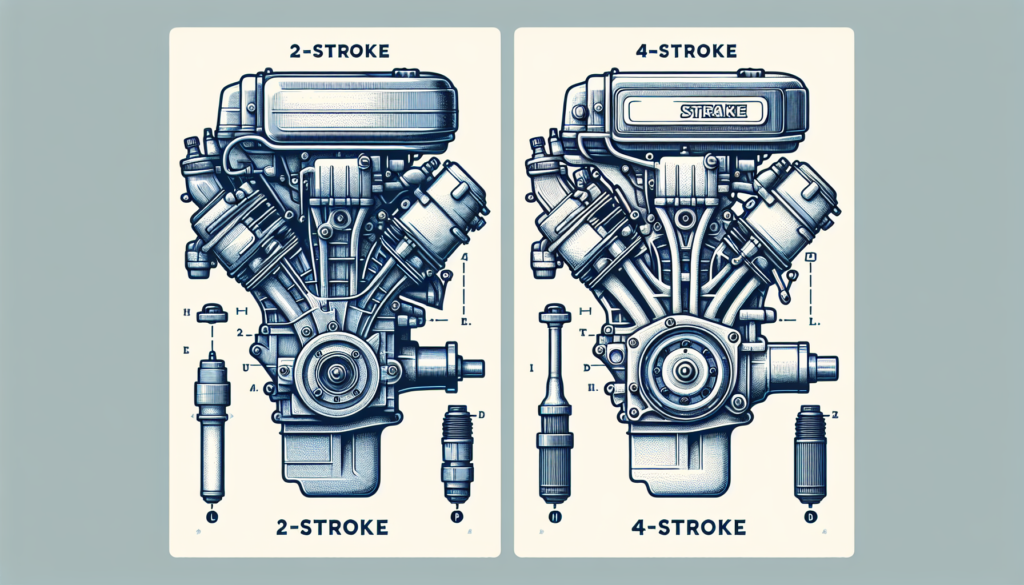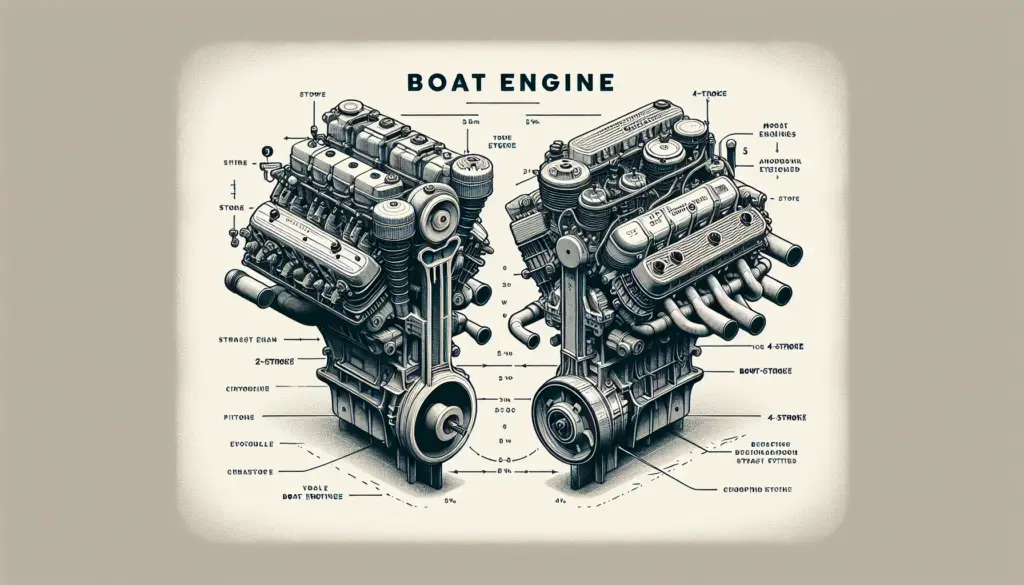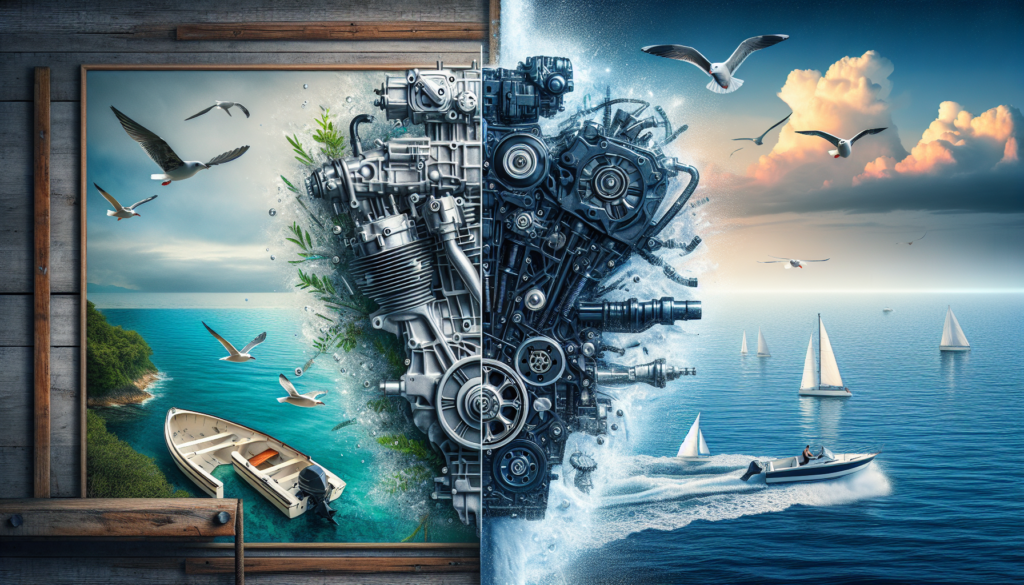Navigating the world of boat engines can sometimes feel like turbulent waters, but the key lies in understanding the basic differences. Take, for instance, the great debate between 2-stroke and 4-stroke boat engines. Your knowledge of these two engine types will not only shape your understanding of boat mechanics, but also influence essential decisions like fuel efficiency and maintenance schedules. In this article, you’ll gain valuable insight about the contrasting features, advantages and potential drawbacks of 2-stroke and 4-stroke boat engines, as well as receive practical advice for making the right choice for your marine adventures.

Understanding the Operation of 2-Stroke Engines
When it comes to boat engines, 2-stroke versions are a popular choice for many boat owners due to their simplicity and raw power. So, let’s dive in and get a grasp on how these engines function.
How 2-stroke engines function
2-stroke engines operate in a cycle of two simple steps hence the name “2-stroke”. This cycle includes compression and combustion. In a 2-stroke engine, the piston’s upward and downward movements, each constituting a stroke, make a complete cycle. This means that there is a power stroke every other cycle, providing more frequent power pulses, which contributes to the high power output typically associated with 2-stroke engines.
The process of fuel intake and combustion in a 2-stroke engine
Fuel intake and combustion in a 2-stroke engine is a swift process. When the piston moves down on the power (or combustion) stroke, it first uncovers the exhaust port, expelling the majority of spent gases. As it continues down, it then uncovers the intake port, allowing the fuel and air mixture to flow into the cylinder. The piston’s subsequent upward movement compresses this mixture. Shortly before reaching the top of its stroke, the spark plug ignites this compressed mixture. The combustion forces the piston back down, commencing another cycle.
Advantages of 2-Stroke engines
One key advantage of 2-stroke engines is their power-to-weight ratio. Given they fire once every revolution, they generally provide twice the power of a 4-stroke engine of the same size. This makes them ideal for applications requiring high power in a lightweight package. Additionally, their simple design makes them cheaper to manufacture and requires less space, contributing to their popularity in small watercraft.
Understanding the Operation of 4-Stroke Engines
Let’s now shift gears and talk about 4-stroke engines, which function in a slightly more complex manner compared to their 2-stroke counterparts.
How 4-stroke engines work
4-stroke engines operate in a cycle of four stages; hence, the name “4-stroke”. These stages are intake, compression, power (or combustion), and exhaust. Each up and down movement of the piston contributes to one of these stages, meaning two full revolutions of the crankshaft are needed to complete one cycle.
Detailing the intake, compression, power, and exhaust strokes of the 4-stroke engine
During the intake stroke, the valve opens to allow a mixture of fuel and air into the cylinder as the piston moves down. The compression stroke follows, the valve closes, and the piston moves up to compress the fuel-air mix. The power comes next, where the spark plug ignites the compressed fuel, forcing the piston down and powering the crankshaft. Lastly, the exhaust stroke expels the spent gases as the piston moves up in preparation for another intake stroke.
Benefits of the 4-Stroke engines
Despite requiring more complex machinery, 4-stroke engines boast several benefits. They tend to be more fuel-efficient than 2-stroke engines, resulting in lower operational costs. They are also generally quieter and smoother, improving the comfort of passengers and crew. Furthermore, they emit fewer pollutants, making them a more eco-friendly choice.

Differentiating Between the Power Output in 2-Stroke and 4-Stroke Engines
In the world of boat engines, power is a key factor to consider, and the output of 2-stroke and 4-stroke engines varies considerably.
Analysing the power cycles in both engine types
In 2-stroke engines, there’s a power stroke with every other stroke, resulting in a power pulse with each revolution of the crankshaft. This results in high power output, making 2-stroke engines great for applications requiring significant power in a compact package.
On the other hand, 4-stroke engines have one power stroke for every two revolutions. This means they produce power pulses less frequently, potentially leading to reduced power output.
Why 2-Stroke engines generally have higher power output
Given their operation cycle, 2-stroke engines inherently provide more power than 4-stroke engines of the same size. They deliver a power stroke with each revolution of the crankshaft, effectively doubling their power output compared to 4-stroke engines.
Efficiency of the power-to-weight ratio in 4-Stroke engines
Despite having lower power output, 4-stroke engines excel in power-to-weight efficiency. Their design allows for better fuel combustion. While they weigh a bit more, the long-term benefits of better fuel efficiency and less frequent maintenance often pay off.
Comparing Fuel Efficiency Between 2-Stroke and 4-Stroke Engines
Fuel efficiency is another crucial consideration when shopping for a boat engine. Let’s see how 2-stroke and 4-stroke engines stack up in this regard.
Why 4-Stroke engines are more fuel efficient
4-stroke engines are generally more fuel-efficient due to their separate intake and compression strokes. This allows for complete combustion, optimizing the engine’s use of fuel and air and reducing waste.
The rate of fuel consumption in 2-Stroke engines
In contrast, 2-stroke engines mix fuel and air intake during the same stroke, which sometimes leads to unburnt fuel being expelled with the exhaust gases. This not only results in increased fuel consumption but also significantly impacts performance.
How the fuel efficiency affects the operation costs
Fuel efficiency goes hand in hand with operation costs. While 2-stroke engines may be cheaper to buy, their higher fuel consumption means you’ll spend more on fuel in the long run. This is where 4-stroke engines shine – they may cost more upfront but will save you money over time due to their superior fuel efficiency.

The Environmental Impact of 2-Stroke and 4-Stroke Engines
When thinking about boat engines, it’s essential to consider their impact on the environment. Both 2-stroke and 4-stroke engines have an environmental footprint, but the extent varies significantly between the two types.
Carbon emissions from both engine types
2-stroke engines tend to emit more pollutants, including carbon dioxide, hydrocarbons, and nitrogen oxides, due to incomplete fuel combustion. On the other hand, 4-stroke engines burn fuel more cleanly and efficiently, resulting in significantly reduced carbon emissions.
Environmental regulations affecting Boat engines
Environmental regulations are increasingly influencing the boating industry. These often target emissions standards, contributing to a shift towards more eco-friendly engines like 4-strokes that produce less pollution.
How 4-Stroke engines are more eco-friendly than 2-Stroke engines
Overall, 4-stroke engines are generally more eco-friendly due to their efficient fuel combustion and lower pollutant emissions. Their design reduces the likelihood of unburnt fuel being expelled into the environment, aligning with the push to build a cleaner and healthier marine environment.
Understanding the Maintenance Needs of 2-Stroke and 4-Stroke Engines
The maintenance practice of boat engines should also be considered when choosing between a 2-stroke and 4-stroke engine.
Typical maintenance practices required for 2-Stroke engines
2-stroke engines generally need more regular maintenance compared to 4-stroke versions. This often includes more frequent oil changes and tune-ups to ensure they perform at their best.
Why 4-Stroke engines require less frequent maintenance
In contrast, 4-stroke engines require oil changes less frequently due to separate oil and fuel systems. Their more complex design reduces wear and tear on individual components, translating into lower overall maintenance needs and, as a result, reduced costs.
The long-term cost implications of maintenance
While the initial cost of a 2-stroke engine may be lower, its higher maintenance demands can lead to a greater total cost of ownership over time. Conversely, a 4-stroke engine may cost more to purchase but could potentially have lower maintenance costs in the long run.

Reviewing the Durability of 2-Stroke and 4-Stroke Engines
Understanding the durability and lifespan of boat engines is essential in ensuring you make an informed purchase decision.
Lifespan expectancy of 2-Stroke engines
The lifespan of a 2-stroke engine can vary widely based on factors such as use and maintenance. Typically, they are capable of providing many years of reliable performance, especially with regular maintenance and proper use.
Why 4-Stroke engines are known to be more durable
4-stroke engines, on the other hand, are generally more durable due to their design and construction. They have more robust components that can withstand wear and tear, resulting in a longer service life. Furthermore, their efficient combustion process reduces deposits of unburnt fuel, contributing to their longevity.
How proper maintenance can extend the lifespan of both engine types
Regardless of the engine type, proper and regular maintenance is essential to extending its lifespan. This includes timely oil changes, tune-ups, and responding to any mechanical issues quickly. Remember, a well-maintained engine results in an overall more reliable and performant boat.
Assessing the Noise Levels and Vibration in 2-Stroke and 4-Stroke Engines
Noise level and vibration can significantly impact the boating experience. Let’s take a look at how 2-stroke and 4-stroke engines compare in this regard.
Why 2-Stroke engines generally produce more noise and vibrations
Due to their high power output and the frequency of power pulses, 2-stroke engines are often noisier and produce more vibrations. While this might not be a major concern for some users, it can be particularly annoying during long trips.
How 4-Stroke engines offer quieter operation
4-stroke engines are generally quieter and smoother. Their operational cycle results in less frequent power pulses, resulting in reduced noise and vibrations. This contributes to a more pleasant and comfortable boating experience for passengers and crew.
Impact of noise and vibration on passengers and crew
Prolonged exposure to high noise levels and vibrations can lead to fatigue and discomfort. As such, choosing an engine type that offers quieter operations can make a significant difference in the overall quality of your boating experience.
A Look at the Cost of 2-Stroke and 4-Stroke Engines
Cost is undoubtedly a paramount consideration when comparing 2-stroke and 4-stroke engines.
Comparing the initial purchase cost of both engine types
In terms of initial cost, 2-stroke engines are usually cheaper. This is primarily due to their simpler and less complex design that requires fewer components to manufacture. On the other hand, 4-stroke engines, due to their more intricate design and superior fuel economy, carry a higher initial purchase price.
Cost benefit analysis considering long-term operation and maintenance costs
However, when long-term costs are factored in, the cost-benefit analysis can swing in favor of 4-stroke engines. Whereas the initial purchase price might be lower for a 2-stroke engine, its higher fuel and maintenance costs can pile up over time. On the other hand, even though a 4-stroke engine might cost more upfront, its superior fuel economy and lower maintenance requirements often result in lower costs in the long run.
How both engine prices are affected by the boat size and engine power
The engine price is also directly influenced by the boat’s size and the required engine power. Larger boats requiring higher-powered engines will inevitably command a higher pricepoint, regardless of whether they are 2-stroke or 4-stroke engines.
The Application of 2-Stroke and 4-Stroke Engines on Different Types of Boats
Finally, these engines are used in a variety of boat types, each with specific needs and requirements.
Types of boats that typically use 2-Stroke engines
2-stroke engines are typically popular with smaller, lightweight boats. Their high power output and lighter weight make them ideally suited for applications like jet skis, dinghies, and small fishing boats.
Why some boat types prefer 4-Stroke engines
Meanwhile, 4-stroke engines are often preferred for larger, heavier boats. Their fuel efficiency, lower noise levels, and smoother operation make them ideal for cruising, and larger sports fishing boats where comfort and long-range capacity are important.
Considerations when choosing engine type for different types of boats
When choosing the kind of engine for your boat, consider factors like the boat’s size, intended use, and how much you’re willing to spend on fuel and maintenance. Remember, comfort, performance, durability, and operating costs are all important aspects to consider when shopping for your ideal boat engine.
In conclusion, both 2-stroke and 4-stroke engines have their strengths and they cater to different needs. It’s all about choosing the one that aligns best with your requirements, preference, and budget.


[…] outside and tend to be easy to service, making them a favourite for small to medium-sizes boats. inboard engines are situated inside the boat’s hull – a preferred option for larger boats due to their […]